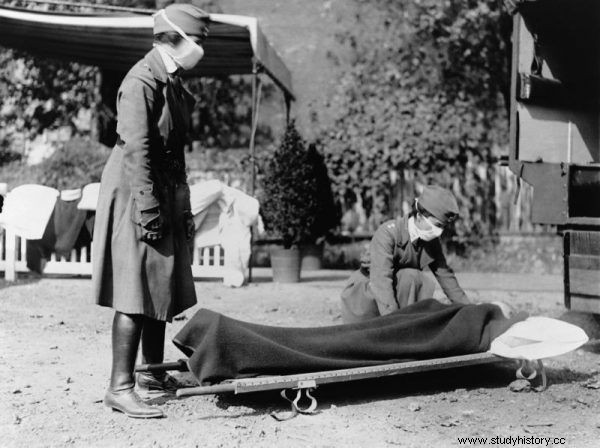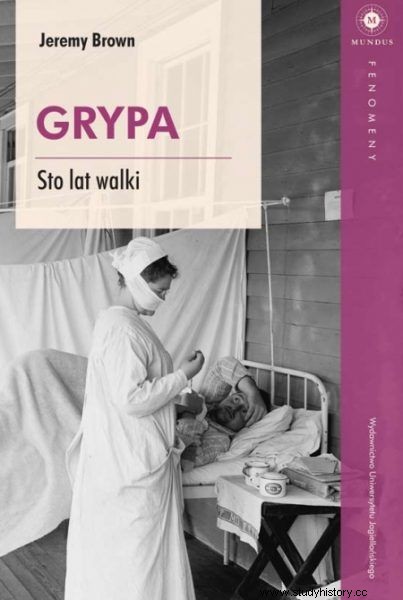A bloody cough and piles of bodies that had to be transported on specially designed trains. Where was the famous "Spanish" born and how did it develop? And what did it have to do with the bond market?
The epidemic has developed almost all over the world. About 30% of the population fell ill. It was the first pandemic since the legendary Black Death of the 14th century. The flu took a very bloody toll - it brought death to more people than World War I.
Where did this virus come from?
Although this specific type of flu was quickly dubbed "Spanish", the origins of the spread of the virus should not be sought there. The name came into common use only because the countries involved in activities on the fronts of World War I carefully censored the flow of information in the media. Neutral Spain, however, did not. The Spanish press wrote about the pandemic . There was no risk of breaking the morale of civilians and war-weary soldiers. However, the origins of the epidemic should not be sought there.
There are three potential virus outbreaks:Kansas County Haskell, France and China.
From the heart of the United States comes the first documented warning of an "unknown disease". Its author was Loring Miner, a provincial doctor, according to whom eighteen people fell ill in one day, three of whom died. The county where the Spanish was probably born was visited by soldiers who quickly returned to military bases where the virus spread much faster.
The second option was France. British virologist John Oxford recorded a flu outbreak in 1916 at a British army base in the south of France.

Demonstration of patient management
The third option is China, which was reported in the New York Times a few months before the epidemic in Europe was raging "a strange flu-like epidemic".
Although today we are unable to confirm where it all began, we know that the virus wreaked havoc and attacked in two waves. The first was relatively gentle. The second took an extremely bloody toll.
Soldiers die
The epidemic spread much faster among the soldiers at the front. Interestingly, the number of cases was more or less the same among soldiers and civilians, but the mortality rate of the former group was much higher than the latter. The reason was the cramped rooms where attempts were made to heal the sick. Infested with the virus were separated only by hanging sheets, so the virus had ideal conditions, causing secondary infections . At Camp Devens, where the earliest reports of a second wave of the virus come from, 90 patients initially reported to the infirmary during the day. Later that number reached five hundred! At one point there were over 6,000 in the infirmary, which had a capacity of 1,200 patients. One of the paramedics mentioned the development of the virus:
We eat it, live in it, sleep in it and dream about it, let alone breathe it for 16 hours a day.
The death rate was so great that one of the barracks was quickly renamed a morgue, and the dead were transported away by special trains. According to the paramedic, the bodies piled gruesome . In one of his letters he wrote:
I saw hundreds of young, sturdy men in their country's uniform come to the infirmary in groups of ten or more. They were placed on their bunks until they were all occupied, while others were pouring in. Their faces soon turned a bluish hue; coughing horribly, they spat out blood. In the morning, the dead bodies were piled up at the morgue like logs of wood.
In most military bases, the course of the epidemic was similar - a few cases turned into hundreds or even thousands. The epidemic suddenly faded out after five or six weeks.

The bond market and the virus
In the spring of 1918, New York began advertising new treasury bonds - Liberty Bonds, the purchase of which was to support the war effort. The promotion was accompanied by wonderful parades attracted by thousands of people, attracted by celebrities like Douglas Fairbanks. In September, about 100,000 "brave" men and women, workers and all patriots gathered in Philadelphia. Jeremy Brown in the book Flu. One Hundred Years of Fighting ”however, he writes:
When they craned their necks to see better, they passed the virus to those around them. The March for Freedom first of all released the virus.
More than 100 people died just two days after the parade. Churches, theaters and schools were closed. It was forbidden to spit in the streets! But it was too late. The only mortuary in the city could accommodate just over 30 bodies. Hundreds of corpses were quickly found there:
There were 10 bodies waiting for each available coffin. The stench of death was everywhere. the local carpenters had given up their usual jobs and the whole time was making only coffins. some funeral directors increased their fees by more than 600 percent (…)
What happened in Philadelphia happened all over the United States. The virus has spread over almost the entire world.
Source:
Trivia is the essence of our website. Short materials devoted to interesting anecdotes, surprising details from the past, strange news from the old press. Reading that will take you no more than 3 minutes, based on single sources. This particular material is based on the book:
- Jeremy Brown “Flu. One Hundred Years of Fighting. Publishing House of the Jagiellonian University 2019.
